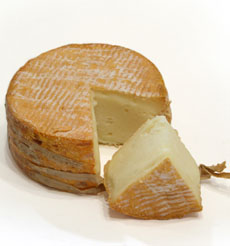
May 2005
Last Updated January 2024
|
 |
Information On Cheese
Cheese Glossary Page 12: Cheese Terms Beginning With U To Z
This is Page 12 of a 12-page glossary of information on cheese. Click on the letters below to find terms of interest. When you’re finished with cheese, visit our many other food glossaries.
Click on a letter to get to the appropriate glossary page.
a b c d e f g h i j k l m n o p q r s t u v w x y z
This glossary is protected by copyright and cannot be reproduced in whole or part.
You are welcome to link to it.
ULTRA-PASTEURIZED
The process of super-heating milk or cream to 275°F for 4 to 15 seconds. Also referred to as UHT. While this keeps the product fresher for a longer period of time, ultra-pasteurized cream is not best for whipping.
UNPASTEURIZED
See raw milk cheese.
| VACHERIN MONT D’OR
Vacherin Mont d’Or (also called Vacherin Mont d’Or, and Vacherin Haut-Doubs) is an Alpine cheese (mountain cheese), different from what most think of as hard Swiss-type cheeses made in large wheels. Instead, Vacherin is a triple-crème, a soft paste that grows gooey and spoonable as it ages. It has been called “the holy grail of raw milk cheeses” for its lusciousness. Vacherin is only made between August 15th and March 15th, when the cows have returned down the mountain from their high summer pastures. At this point, their milk is too fatty and not plentiful enough to make whole wheels of Comté. The Comté co-operatives then turn their hands to making this truly splendid, seasonal cheese. There are only 11 producers of Vacherin Mont d’Or.
|
|
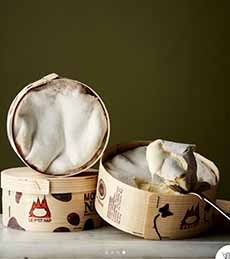
Machein Mont d’Or (photo © Fine Cheese Co.). |
|
VEGETARIAN CHEESE
A cheese that is not made with rennet. Rennet, a dried extract of the rennet membrane of a calf, is used to curdle the milk in the cheese-making process. Animal products are not eaten by vegetarians. Vegetarian cheeses like paneer are curdled with lemon juice, other food acids, or vegetable “rennets.”
WASHED CURD
During the cooking process, half of the whey is removed and replaced with water at the same temperature to speed up the shrinking process (syneresis). Examples include Edam and Gouda.
|
|
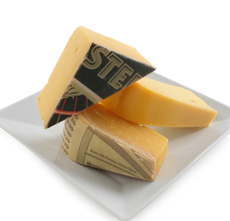
Gouda, a washed curd cheese, is available at iGourmet.com. |
|
WASHED RIND CHEESES
Washed rind cheeses, known for their powerful aromas, are surface-ripened by washing and brushing the cheese throughout the ripening/aging process with brine, beer, wine, brandy, a mixture of these ingredients, or any other interesting liquid that will impart flavor and create a different chemical balance for the growth of the bacteria, Breyibacterium linens, which ripens from the outside in by breaking down the proteins and fats inside. The rind is cleaned and brushed off, which causes the cheese to age more quickly, enhancing the flavor and acidity of the cheese and creating a bolder, more noticeable tang.
|
|
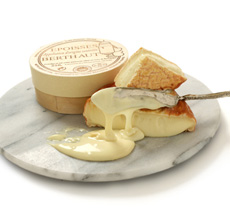
Epoisses, a divinely creamy and pungent cheese. If you like this style, also try Stinking Bishop. Both are available at iGourmet.com. |
Washed rind cheeses also are called red surface bacteria cheeses, though the colors range from light pink to orange to brown. The tint is from the B. linens, which covers the cheese, but the color also can be faked with annatto. The longer the cheeses are left to ripen, the stronger the aroma, which is the inspiration behind the phrase, “It is not cheese that smells of feet, it is feet that smell of cheese.” Most of the aromatics will ripen into soft, pungent cheeses; however, some aromatics are firm cheeses that will never go soft. The most infamous of this group is the brandy-washed French classic, Epoisses (see photo above). Other examples include Livarot, Munster, Prattigau, Pont L’Eveque, Saint Nectaire, Stinking Bishop, and Taleggio. The aging period usually ranges from 6 to 8 weeks, and the cheeses have a shelf life of 5 to 6 weeks.
The strong aroma is deliberate. This “barnyard”-smelling cheese style was developed in the early 16th century by French Cistercian monks at L’Abbaye de Citeaux outside the village of Époisses. One monk there discovered that brushing the rind of a young cheese with brandy encouraged the growth of orange bacteria, which added body and aroma to the cheese. The cheese came to be called Époisses de Bourgogne (Époisses for short). It became very popular, although today, in less odoriferous times, it is illegal to carry an Époisses cheese on the public railways.
|
WATER BUFFALO’S MILK
Snow white in color, water buffalo’s milk is very thick and creamy. It contains less water and more solids (protein) than cow’s milk, as well as high levels of the antioxidant tocopherol. It has largely been made into fresh cheese, specifically, buffalo mozzarella (mozzarella di bufala), a tastier alternative to cow’s milk mozzarella. Recently, new semi-aged Italian water buffalo cheese, caciotta di bufala, a soft, rich, creamy cheese with delicate flavor and the slightly tart aftertaste of buffalo’s milk. Also see cow’s milk, goat’s milk, and sheep’s milk.
|
|
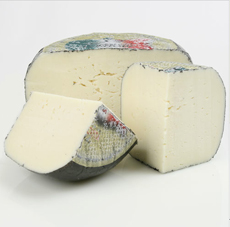
Caciotta di bufala is a new, semi-aged Italian water buffalo cheese, available at iGourmet.com. |
WHEY
|
Whey is the liquid portion of milk after the solids (protein and fat) have been extracted. The solids become curds when an acid (vinegar, lemon juice) or enzymes are added. Whey is a high acidity by-product; the more whey that is removed during production, the drier the cheese will be. Whey is reheated to make ricotta cheese (ricotta means re-cooked) and is used to make the Norwegian goat cheese, gjetost. The by-product is used to add nutrients to animal feed and make high-protein drinks, infant formula, and bakery products.
|
|
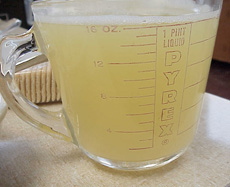
Whey. Photo courtesy of Oregon State University. |
When Little Miss Muffet was sitting on her tuffet eating her curds and whey, she was eating cottage cheese, which contains a good deal of whey. A hard, dry cheese like Parmesan, on the other hand, contains very little whey. See also curds.
|
WHEY CHEESE
When milk is renneted and set, the solids become curds and the liquids become whey. This liquid contains a percentage of the albuminous proteins that were in the milk from the start but which the rennet didn’t capture in the curd. The method of capturing this leftover protein is with high heat and an acid, like vinegar. The protein coagulates at about 175°F with the addition of acid (vinegar or other), into a very light mass creating the great fresh cheese, ricotta. Examples include ricotta and gjetost.
YOGURT CHEESE
See labneh.
|
|
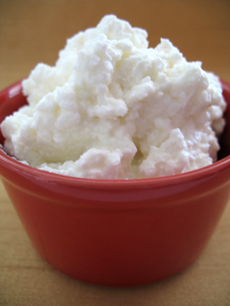
Fresh ricotta from Mozzarella Fresca, a NIBBLE Top Pick Of The Week. Read our review. |
Go To The Article Index Above
Lifestyle Direct, Inc. All rights reserved. Some material copyright Murray’s Cheese. Images are the copyright of their respective owners.

|




